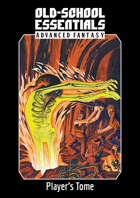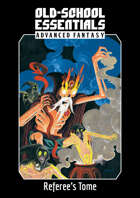A website dedicate to games of all favors and varieties, from video games to good old D&D.
Wednesday, October 13, 2021
Sunday, October 10, 2021
Review - Necrotic Gnome's Old School Essentials Advanced Fantasy
Allelujah! I found a great title to start with, Necrotic Gnome's Old-School Essentials Advanced Fantasy.
I lost my 1e books and wanted a replacement. I know Necrotic Gnome has been threatening me with a Kickstarter of physical books, but I couldn't wait for a printed copy. I ordered both the Player's Tome and Referee's Tome from DriveThruRPG. Previously, I had been making do with the short free edition which is pretty fine.
| Title: Advanced Fantasy Player's Tome Rule Set: Old-School Essentials Year: 2021 Author: Gavin Norman Publisher: Necrotic Gnome Pages: 257 pages Rating: 5 of 5 Gold Stars |
|
Title: Advanced Fantasy Referee's Tome Rule Set: Old-School Essentials Year: 2021 Author: Gavin Norman Publisher: Necrotic Gnome Pages: 257 pages Rating: 5 of 5 Gold Stars |
|
What I was expecting was an updated rendition of the 1e D&D books. I was wrong.
These books have more in common with the B/X sets or perhaps the Rules Cyclopedia. But wait! That's not all. The author, Gavin Norman set out to refine B/X by remove some warts and flaws. Not only was he successful, but he also went on to fix all of the Unearthed Arcana classes and the accursed Bard class of e1. Somehow, he has three different editions fused in one. Impressive.
What fascinates me the most is how there is a basic and advanced method of character generation. The basic method uses race as a class while the advanced method allows all races to engage in a class. With a tiny modification, this is exactly how I play. The rules do not say is if you can mix basic and advanced methods of characters, but why the hell not. I allow for Basic Elves and AD&D Elven Clerics.
The books are well-paced for teaching new players from a single set of books, which is right in line with what the original B/X books did. Timely information is presented when it's needed and not before. Mr. Norman has also rolled in some welcome updates, such as THAC0 and ascending AC. I hate them both because they are too user-friendly, but this set competently explains all three methods to suit the taste of all three player bases.
Both books are 257 pages long a-piece. The Player's Tome is really the shining star of the set as it contains the most varied information. The Referee's Tome approximates the DMG and Monster Manual of e1 all in one book. B/X didn't have a DMG until the Red Box if I remember correctly and this format avoids getting all murky like the e1 DMG.
So, where are the flaws? Well, there aren't any or many that I could find. More like chatter from the peanut gallery.
The one thing that amused me was the author named a spell "Pass-Wall". Back in the Moldvay version of B/X, it was spelled "Passwall" and was completely omitted from the books except for the Staff of Wizardry description, which doesn't explain the spell. See, real peanut gallery stuff.
I am not a fan of the short monster stat blocks like a module synopsis but have to admit it allows for the presentation of far more critters than a full quarter page stat block of the e1 Monster Manual. I always got warm fuzzies when I found a module that included an appendix with full stat blocks for new monsters. If Necrotic Gnome changed its mind and created a Monster Manual with full stat blocks, I'd totally buy that.
The last item, I don't even know how to quantify. There is too much art. WTF? Did I say that? I love all of the art, but the format is meant for the beautiful full-color, hardback version of the book. I have a printable pdf. If I print this thing, it's going to have qualities similar to a '79 era xerox. That makes me sad and I can't wait to purchase a hard copy.
There you have it, I found three flaws and two of them make me want to purchase a physical copy of something I already have.
So, I guess this is another 5 gold star review. But you don't have to take my word for it, check out what some other reviewers said about this set:
RPG.net Review: "The bullet-point presentation hits the sweet spot when it comes to saving space (and thus cramming more material between the books' pages) as well as creating concise texts with zero ambiguity."
Reviews from R'lyeh: "What is notable with all of these Classes is that the designer has tried to keep them unique, to keep their abilities from encroaching on those of Classes, and to keep them from being too powerful."
Mr. Tim Brannan gives the physical set a glorious, jealously inducing review on The Other Side Blog. I can't wait for these to become available again.
Again, if you haven't followed these bloggers, now is the time. Or you could cut to the chase and follow Campaign Wiki's OSR feed. It is amazing.
Wednesday, October 6, 2021
Introduction: How to...
D&D Basic Set Rulebook (B/X ed.) (Basic) D&D Basic Set Rulebook (B/X ed.) (Basic) | D&D Expert Set Rulebook (B/X ed.) (Basic) D&D Expert Set Rulebook (B/X ed.) (Basic) |
HP-14dk1000 Laptop Review
Normally I would place hardware reviews over on Unpwnd.com but this one is special. It makes my website and games go.
This particular HP is only available from Best Buy. At the $299 price point, you know this isn't a gaming machine.
Here are the stats:- Screen Size: 14 inches
- Screen Resolution: 1366 x 768 (HD)
- Processor Model: AMD Athlon Silver 3000 Series
- Processor Model Number: AMD Athlon Silver 3050U
- Processor Speed (Base): 2.3 gigahertz
- Solid State Drive Capacity: 128 gigabytes
- System Memory (RAM): 4 gigabytes
- Graphics: AMD Radeon
- Operating System: Windows 10 Home in S Mode
- Battery Life: (up to) 8 hours
Off the Shelf Review - Project Hail Mary by Andy Weir
I am a huge fan of Andy Weir, author of the Martian. Project Hail Mary is an excellent science-themed page-turner.
Title: Project Hail Mary
Year: 2021
Author: Andy Weir
Pages: 476 pages
Rating: 4 of 5 stars
Meet male, caucasian astronaut. He's adrift in space, destination unknown, mission unknown, name unknown. Weir rapidly builds our hero up in just 2 chapters without annoying the reader with the fact that he has no name or purpose. He also threads the needle with the hero to prove he isn't a recast version of Mark Watney from The Martian.
Our astronaut is quickly introduced to two different problems. One is immediate, an inflated catheter in his... ah... you know. And the second more distant, an infrared glow around Venus. (Hey, I didn't write it. Well, I did but...) The second becomes the major problem of the story, no matter how immediate the other problem would be. Something is drawing energy from the Sun to the orbit of Venus. The sun isn't dying but the dimming will kill every living thing on Earth. If anyone is to solve this problem, one hell of a Hail Mary is needed.
Here is our hero and his ship, the Hail Mary. Full of Dr. Grace.
Weir likes solid science in his science fiction. He uses a couple of handwaves to get our hero into deep space. The major handwave is energy to mass ratios of fuel. Aside from that, I'm sure he took a couple of liberties with biology, but each choice was a smart, calculated one. In this novel, Grace and science are the heroes jointly.
Weir uses Grace's memory loss as a convenient way to place him where he needs to be and then uses the resulting recovery of memory as excellently timed data dumps for the reader. It is used to great effect to expand the stage of the Hail Mary to a greater cast of characters than just Dr. Grace. The reader moves from the present to the past in a delicate dance of memory vs. discovery where Dr. Grace is first introduced to the world end cataclysm that he must prevent.
And damn, some of these characters are excellent. Even magnificent. Eva Stratt is the quarterback of Earth's defenses. She is assigned the task of clearing the way for Project Hail Mary's success. Since success is not assured, Stratt operates on the principle that anything short of total annihilation is a path to success. Including a suicide mission to Tau Ceti to find out why this Earthly neighbor isn't dimming when all of the other stars are. And boy, is she a bastard.
Many of the other characters are charming and likable, even when not compared to Stratt. But none are entirely squeaky clean. Weir builds a cast of believable characters, with very few unnecessary bit characters to muck up the works. Some of the characters are particularly odd, given that they want to go on a suicide mission. And some of that oddly is pretty shocking. But not terrible, in context.
Dr. Grace encounters both wonders and surprises unimagined by the builders of the Hail Mary and each is used to excellent advantage to progress the story.
As a plot device, all of the science onboard the Hail Mary is off the shelf, except for the technology to place the crew in a coma long enough to survive the trip. That is the one point of failure on the mission. If the crew never emerges from the coma, the mission is a failure. Having no other option, that is deemed an acceptable risk.
However, there is a sneaky backdoor point of technology failure introduced by the plot. First, none of the technology at Grace's disposal is any smarter than a laptop or more sophisticated than a college chemistry lab. Dr. Grace isn't an astronaut. He doesn't do checklists or planning because he isn't trained to do so. And pays for it constantly. There is nothing there to warn him of the errors of his ways.
While this would normally be a plot hole, the fact that Grace pays for his erratic and Rocky behavior every time builds tension and drama, all the way to the climax of the story. And it's a hell of an ending, which parallels Mark Waverly's transition from astronaut to teacher in the Martian.
While Project Hail Mary is a very different read from the Martian, the sense pedigree is there.
I am slightly annoyed that I paid full price for this book at Barnes and Nobles, but it was a much needed date night.>
Or you can do what I did for Artemis and grab the Audible version.




























